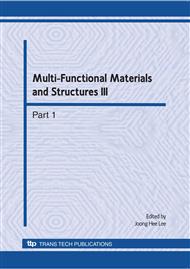p.459
p.463
p.467
p.471
p.475
p.479
p.483
p.487
p.491
Evaluation on the Sound Absorption and Mechanical Property of the Multi-Layer Needle-Punching Nonwoven
Abstract:
In this research, we used the special needle punching process to improve the disadvantages of the ordinary needle punching process. First, we manufactured the single-layer needle punching nonwoven by the ordinary needle punching process and then nonwovens were laminated followed by needle punching. We carried on this manufacturing processing until the multiple needle-punching nonwoven reached the certain thickness and area weight which were both limited in the ordinary needle punching process. The combination of two manufacture techniques as multiple thermal bonding and multiple needle-punching freed the single needle-punching from the limit of the expected thickness and area density. In this research, we tested the mechanical properties and sound absorption of the multi-layer needle-punching nonwoven and multi-layer thermal bonding nonwoven. According to the results, the tensile strength is higher than the multi-layer thermal bonding nonwoven; however, there was no distinct difference between the multi-layer needle-punching nonwoven and multi-layer thermal bonding nonwoven on the sound absorption performance.
Info:
Periodical:
Pages:
475-478
Citation:
Online since:
August 2010
Authors:
Keywords:
Price:
Сopyright:
© 2010 Trans Tech Publications Ltd. All Rights Reserved
Share:
Citation:


